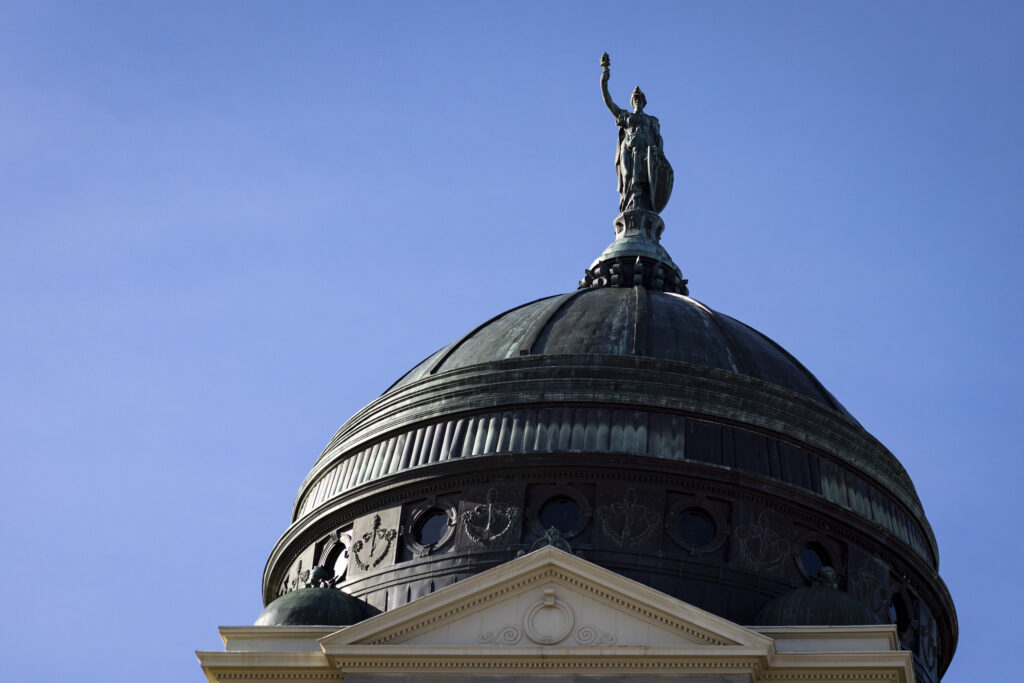
The Montana State Capitol in Helena on Wednesday, April 26, 2023. (Photo by Mike Clark for the Daily Montanan)
If you earn less than $26,700, you’ll see another $39 or so from the income tax cut proposed by Gov. Greg Gianforte, according to a budget analysis from a state policy nonprofit.
On the other hand, if your wallet is fat from a salary of $749,001, you’ll get another $9,577, according to the estimate.
Earlier this month, the Governor’s Office proposed what it described as “the largest income tax cut in state history” in its upcoming budget, reducing the rate most Montanans pay from 5.9% to 4.9%.
The proposal from the Republican governor also increases the earned income tax credit to benefit lower- and middle-income Montanans.
“Taken together, those two proposals provide Montanans with $850 million in permanent income tax relief,” said the Governor’s Office in a press release.
The Montana Legislature will take up that budget in its 2025 session, and the income tax cuts are already drawing scrutiny.
At a press conference Democrats held this week in response to the governor’s budget, Rep. Mary Caferro, of Helena, criticized the cuts as providing a cattywampus benefit — with 75% of the savings going to 20% of Montanans.
In fact, Caferro said most Montanans in the middle would see little extra money at all.
“Their tax cuts will be about two tanks of gas,” said Caferro, vice chairperson of appropriations.
However, Sen. Greg Hertz, chairperson of Senate Taxation, said Wednesday states that don’t have income taxes at all are more competitive for businesses.
And the balance of who pays income taxes in Montana is already lopsided, said Hertz, a Polson Republican.
“The bottom 50% of people in Montana pay 6% of all income taxes,” Hertz said. “The top 10% pay 58% of all income taxes.”
According to an analysis by the Montana Budget and Policy Center, the cost of the rate reduction would be $255 million per

year, or 25 times larger than the cost of the earned income tax credit expansion.
The center analyzed the proposal from the Governor’s Office using an Institute on Taxation and Economic Policy model.
The analysis found the wealthiest Montana households earning more than $749,000 would see a tax cut of nearly $10,000.
Families earning $30,000 to $85,000 would see a cut of $40 to $115, according to the Montana Budget and Policy Center.
“The way our tax code has been structured has disproportionately benefited white, wealthy individuals, while families living on lower incomes pay a higher share of their income taxes,” said the analysis from the Budget and Policy Center.
“Unfortunately, the Governor’s proposed budget will exacerbate these inequities through massive income tax cuts aimed at the wealthiest households, costing the state hundred of millions in lost revenue.”
In a statement from the Governor’s Office, however, spokesperson Kaitlin Price said every Montanan stands to gain.
“The governor’s budget proposal includes $850 million in permanent tax relief for hardworking Montanans — a new record tax cut that benefits Montanans at every income level,” Price said.
In a phone call and email, Hertz said people on the low end of the salary scale don’t contribute much to state coffers to begin with, citing data from the Department of Revenue.

“The 1% proposed tax reduction will reduce taxes more for the top taxpayers as they pay the most,” Hertz said in an email. “The tax cut will also be combined with increasing Montana’s earned income tax credit that is a refundable tax credit benefiting low-income working families.
“This tax reduction and increase in the EITC will benefit all taxpayers.”
Hertz also said a bill from 2021, Senate Bill 399, took nearly 100,000 low-income Montanans off of the tax rolls, the result of the state matching the federal standard deduction.
He said it means single earners don’t pay income taxes on the first $15,000 of income, and couples don’t pay on their first $30,000.
In other words, he said, the state has helped people on the lower end of the income scale already. He said the bill took effect in January 2024, and its effects are permanent.
Generally, Hertz said he supports the concept of an income tax cut, but he also wants to take a closer look at the effects on the state revenue stream.
“It’s a balance. You need to be sure you have revenue to provide services,” Hertz said.
At the same time, Hertz said Montana could use a boost when it comes to attracting business investment to the state.
“We need to be competitive in the Rocky Mountain region, and right now, we’re not as competitive as we should be,” said Hertz, also a business owner.
Heather O’Loughlin, executive director of the Montana Budget and Policy Center, said details of the governor’s budget proposal aren’t completely fleshed out yet, but the governor has cut the top rate for income taxes every session, and the current proposal is large.
“This would be a significant cut in revenue disproportionately benefiting wealthy households and does raise the question of, ‘What does it mean for budget investments in the future?’”
At the press conference Monday, Caferro also said she worried about the sustainability of the cuts for the needs of the state.
“The one coming up is the biggest, and we have stuff in our budget that needs to be taken care of,” Caferro said.

